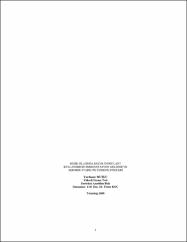| dc.contributor.author | Mutlu, Yurdanur | |
| dc.date.accessioned | 2017-04-28T06:57:26Z | |
| dc.date.available | 2017-04-28T06:57:26Z | |
| dc.date.issued | 2009 | |
| dc.identifier.uri | https://hdl.handle.net/20.500.11776/520 | |
| dc.description.abstract | Bu çalısma ile inokulant hazırlama süresi ve dozunun mısır silajının fermantasyon gelisimi üzerine etkilerinin laboratuar kosularında saptanması amacı ile düzenlenmistir Mısır, hamur olum döneminde hasat edilmistir. Arastırmada içeriginde Lactobacillus plantarum, Lactobacillus brevis, Propionibacterium shermanii, Enterococcus faecium, Bacillus subsitus, Pediococcus acidilactici ve alpha–Amylase (A.oryzae), cellulase ve hemicellulase (A. niger) içeren MICROBIOS (Cuprem®, USA) adlı ticari inokulant kulanılmıstır. nokulant silajlara 10.0 ve 10.30 kob cfu/g düzeyinde katılmıslardır. Uygulamalardan sonra muameleler yalnızca gaz çıkısına olanak tanıyan, 1,0 litrelik özel kavanozlara silolanmıstır. Kavanozlar laboratuvar kosullarında 25±2°C'de depolanmıslardır. Silolamadan sonraki 4., 7., 14., 21. ve 55. günlerde her gruptan 3'er kavanoz açılarak silajlarda kimyasal ve mikrobiyolojik analizler yapılmıstır. Silolama döneminin sonunda açılan tüm silajlara 5 gün süre ile aerobik stabilite testi uygulanmıstır. Sonuç olarak dozun artırılması silaj fermantasyonunu ve aerobik stabiliteyi olumlu yönde etkilememistir. | en_US |
| dc.description.abstract | This study was carried out to determine the effects of inoculant preparation time and doses on fermentation profiles of the maize ensiled under laboratory conditions. Maize was harvested at the dough stage. A commercial inoculant MICROBIOS (Cuprem®, USA) containing Lactobacillus plantarum, Lactobacillus brevis, Propionibacterium shermanii, Enterococcus faecium, Bacillus subsitus, Pediococcus acidilactici and alpha–Amylase (A.oryzae), cellulase and hemicellulase (A. niger) was used in this study. Inoculants were applied to silages 10.0 and 10.30 log cfu/g levels. After treatment, the chopped maize was ensiled in 1.0-l special anaerobic jars, equipped with a lid that enables gas release only. Three jars from each group were sampled for chemical and microbiological analysis on days 4., 7., 14., 21. and 55. after ensiling. At the end of the experiment the silages were also subjected to an aerobic stability test, lasting 5 days The study shows that doubling the rate of inoculant application was not effective than the recommended rate at enhancing the quality or aerobic stability of maize silage. | en_US |
| dc.language.iso | tur | en_US |
| dc.publisher | Namık Kemal Üniversitesi | en_US |
| dc.rights | info:eu-repo/semantics/openAccess | en_US |
| dc.subject | Mısır silajı | en_US |
| dc.subject | doz | en_US |
| dc.subject | inokulant hazırlama zamanı | en_US |
| dc.subject | silaj fermantasyonu | en_US |
| dc.subject | Maize silage | en_US |
| dc.subject | dose | en_US |
| dc.subject | inoculant preparation time | en_US |
| dc.subject | silage fermentation | en_US |
| dc.title | Mısır silajında enzim-inokulant kullanımının fermantasyon gelişimi ve aerobik stabilite üzerine etkileri | en_US |
| dc.title.alternative | The effects of enzyme - inoculants on the fermentation and aerobic stability characteristics of maize silages | en_US |
| dc.type | masterThesis | en_US |
| dc.department | Enstitüler, Fen Bilimleri Enstitüsü, Zootekni Ana Bilim Dalı | en_US |
| dc.relation.publicationcategory | Tez | en_US |



















